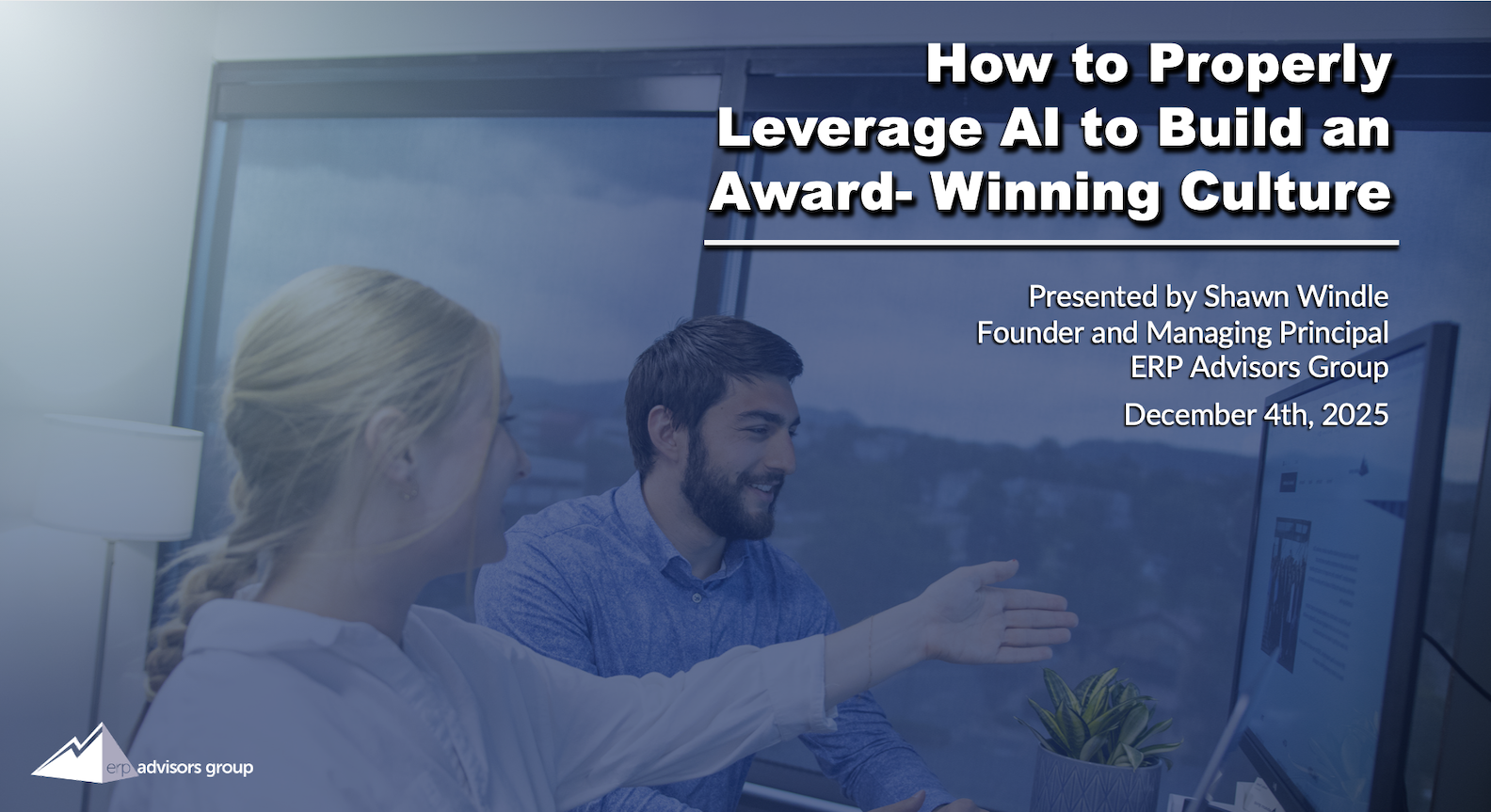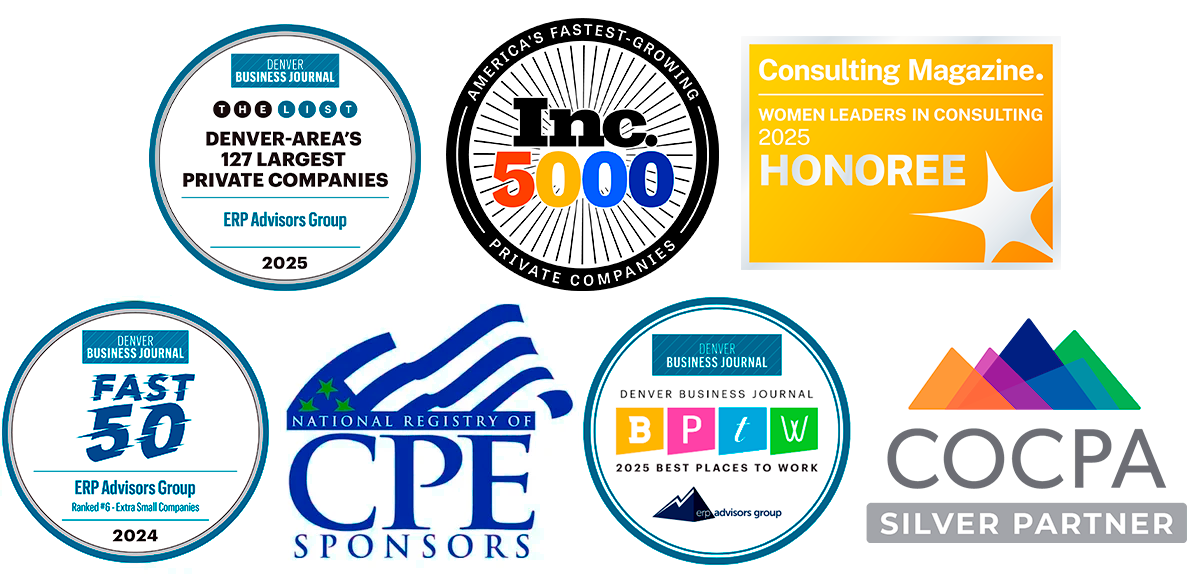
In this article, we will outline the entire ERP selection process, laying to rest unnecessary complications, antiquated data, and general misconceptions about these projects. It helps to break ERP Selection into 4 parts: understanding what an ERP is, what your real needs are, what vendors are really offering, and what it will take to implement a new ERP system.
1) Understand What an ERP Is
Look across the whole business, at all the business processes, resources, and data; develop a plan for integrating and organizing all of that, and you have an ERP. Since 2000, these systems have also started to signify not only the operational aspects of the business, but also Sales and Marketing systems, like Salesforce, Pardot, and many others.
Why Is ERP a philosophical approach, not just a piece of software?
ERP in the most classical sense used to be one single system you bought. In the early 2000s, companies would buy Oracle, SAP, or JDEdwards and roll out that single business suite across the whole company. That’s not the way ERP is today. Although you can still approach these same companies for a business suite, you should also be aware of other potentially more valuable ways to design holistic business software.
Best-of-Breed
Best-of-breed applications today increase the value of mixing and matching vendors. You might buy a Customer Relationship Management (CRM) system like Salesforce for sales teams and a Human Capital Management system like Ultimate for employee lifecycle; you might buy Demandware for your eCommerce solution etc. There are so many of these systems out there driving real innovations within their particular specialization, that the best-of-breed approach to the ERP market has a lot of merit.
Hybrid
One step between best-of-breed and a single ERP is the hybrid model. In this scenario, you pair one main application like a good Financials-based ERP with one or two applications with rich functionality that users in that business area will appreciate. Best-of-breed solutions can really increase the automation of manual tasks while satisfying end users with the functionality they need.
ERP is essentially a foundation of software that accommodates the flow of data through your business processes.
In considering your ERP project, look at ERP as a philosophical approach.
- Setting up Software
Enterprise software is, for instance, the application you use to create and track business processes. For instance: sales orders. You go into an order application; you enter information about the customer, what they’ve bought, pricing information, shipping information, etc. Configuration is setting up that entry screen so that it meets your needs for your sales orders.
- Business Process
All the work done to take a customer from prospect, to lead, to opportunity, to close, to fulfillment, that is your business process.
- Data
Business objects, sales orders, customers, products, prices, etc.
2) Understand Your Real Needs for an ERP
Taking an objective approach to ERP allows you to be quite specific about the problems your organization faces in managing the business environment and achieving its strategy. The first action step to take is to understand the problems that software can alleviate.
- Map business processes from beginning to end
- Identify pain points and bottlenecks
- Focus on pain points and manual processes that can be fixed with software
- Go back to every group that has a software-driven pain point and ask the users what they need to solve the pain
This interviewing process should leave you two things. First, you will have an understanding of exactly the kind of tools your users need to overcome pain points and you will also start to build user buy-in. This ensures that when you do roll out the new solution, you have enlisted user buy-in and input which will lead to acceptance.
3) Understand What Vendors Are Really Offering
Most companies think that product demos convey exactly what vendors are offering, but this is not the case. Here’s how you can make 100% sure you walk away with a real understanding — not of what the product does, but what it will do for you.
Start by Telling the Vendor Your Requirements
You have a list of pain points, user buy-in, and a specific understanding of what the software will need to do to alleviate those pain points. Now, transcribe that work into bullet points, and show it to vendors. You want to ensure they hit each bullet point in their demos.
Make Sure Subject Matter Experts (SMEs) Attend Product Demos
SMEs are the best-equipped to understand whether the product will actually meet their needs or not. Provide them a scorecard with the requirements so that they can provide quantitative feedback on each capability. Give the scorecard to the vendors too.
Understand the How: Vendor Services
Vendors are not only offering software; they are offering services to put the software in place to match your business process. You need to understand their implementation fully before you can sign a deal with them. Understand:
- Methodology
- Resources
- Cost
- Milestones
- Estimated Timing
Hold an Executive Sponsor Meeting and Review the Vendor’s Development Roadmap
Ideally, you want a key person from the software vendor to discuss the future development roadmap with executives. This is a critical meeting because it accomplishes a number of key objectives simultaneously.
- Builds executive buy-in for the project
- Ensures you can hold a key contact accountable for project success
- Get contact information and build rapport
- Conveys your commitment to make the project a success
Understand the Vendor Contract before You Sign
This topic might sound a bit deeper than the rest — because it is. There are so many components to these contracts to understand: discounts, renewal caps, payment terms, terms and conditions. You really need to know your way around these documents. Check out our guide to contract negotiations.
4) Understand What It Will Really Take to Implement ERP Software
Select an implementation vendor that you would bet your job on — because you are.
Make Sure the Implementation Partner Offers Exactly What You Need
Ensure the tasks and budgets and statement of work, everything that is included in the ERP implementation contract will be exactly what you need.
Look at Internal Resource Requirements
The other side of training is internal. How will your employees train on the new software? Do they have the free time allotted for change? Who will manage the process? These last two pieces of advice work together as you understand your organization’s role in adoption.
Final Key Tip: Don’t call salespeople before you understand your needs
Vendors know their applications, their solutions, and the problems they solve.
Be sure you know exactly what you need before approaching them, and you will impress your needs on them, not vice versa.
We hope these articles have helped you clarify and demystify the ERP Selection Process. If you are interested in speaking with an ERP Selection Consultant call us if you have any questions. We want to make sure you are heading in the right direction.
Juliette Welch: Good afternoon everyone. Thanks for joining us for today's call: Demystifying the ERP Selection Process.
Shawn Windle is our speaker for today. Shawn is the Founder and Managing Principal of ERP Advisors Group based here in Denver, Colorado.
ERP Advisors group is one of the country's top independent enterprise software advisory firms. ERP Advisors Group advises mid to large sized businesses on selecting and implementing business applications from enterprise resource planning, customer relationship management, human capital management, business intelligence, and other enterprise applications which equate to millions of dollars in software deals each year across many industries.
On today's call, Shawn will help take the mystery out of selecting a new ERP and discuss how running a rigorous selection process will ensure you choose the right software for your needs.
Shawn, I'm going to go ahead and hand it off to you now.
Shawn Windle: Okay, thanks Juliette. And just a quick sound check again. Everything is fine?
Juliette: Yep, sounds great.
Shawn: Perfect. Well, let's jump into this. So, demystifying the ERP selection process, that's a fun topic.
It's a bit unfortunate that the ERP selection process contains a lot of mystery, but much like anything else in life, where there's mystery, if we can build understanding, the mystery goes away.
So, we go less from an art and more towards a science. And in this call, I want to give you four very specific points on what you have to understand when you're doing a software selection process, and I think that will help to demystify it.
So, the four points I'm going to go through are understand what ERP is — that's the first one. The second one is understand your real needs for an ERP. The third is understand what the vendors are really offering. And the fourth is understand what it will really take to implement your ERP software.
So, I think with those four points well understood, there will be much less mystery. And at the end of the call, I have one more tip that will definitely demystify it as well. So, stick through that and I'll give it to you.
Okay, so the first point here is understand what ERP is. Now we have lots of white papers and different webcasts and podcasts and things that are available on this topic, but I'm just going to give you a short summary — kind of the CliffsNotes of what ERP is.
So, we look at ERP as a philosophical approach to setting up software to automate your business processes and capture and report on the data that is generated from those processes. So, what the heck does that really mean?
It's actually pretty straightforward. Basically, you all understand enterprise software and what software is — having applications that are written and coded that track your business processes, so things like creating a sales order. Super simple.
You go into an application — the software application — you enter any information about the customer, what they thought, pricing information, shipping information, many other things, and you’re there. That’s what software is.
Configured is setting up that sales order entry screen so that it meets what you need for your sales orders.
As an example, business process. Business process is going from the very beginning of we have a lead, we go to an opportunity, we close that, we book the business, we create a sales order, we send that through the fulfillment. That's the business process.
Data is really the business objects that you have in your business. The sales order is one, a customer is one, the product that you sell price.
So again, I want you to just fundamentally understand what ERP is. And again, it's a philosophical approach to setting up software, automate your business processes, and capture and report on the data that is generated from those processes. That's it. It doesn't have to be any more complex.
Now, it used to be that ERP was really like one big system that you bought. Like I'm actually right now — today in the vendor demonstration at a company I used to work with 20 years ago. I'm at that same office, it's moved and transitioned a couple times and ownership.
But when I worked at JD Edwards back at the early 2000s, companies would buy that application, they’d roll it out across the whole company or they’d buy Oracle E-Business Suite and roll it out across the whole company — or SAP and roll it out across the whole company. That was what ERP was.
But that's not the way it is anymore. That's why we call it a philosophical approach, because there are many best of breed applications in the market.
You may buy a CRM system like Salesforce — customer relationship management — and maybe a human capital management system like Ultimate for your employee lifecycle. You may even buy a Demandware for your demand planning. Or you might even get into Arena for your product lifecycle management.
There's so many software apps in the market today that ERP isn't just go buy one app and roll it out across the whole company, you actually buy multiple apps and roll it out across functional areas.
That's one deployment model, too, so you can have the all-in-one. You can have best of breeds that do each individual function and then you can also have more of a hybrid let's say for a professional services firm where you have a system that tracks your projects and does your project resource scheduling and billing and then it integrates and has its own accounting system, but then maybe you have a separate HR system.
So again, I'm helping you to understand what ERP really is here, but know that it's not just, oh, I'll just go to the market and buy an ERP software — it doesn't work that way. Look at it as a philosophy for how you approach your software and business processes and data management in your business.
So, that's basically what ERP is.
So, that's the first thing you want to do to demystify the ERP selection process is understand what the heck ERP really even is.
And ERP, by the way, stands for enterprise resource planning. So, look across the whole business, all of the resources and data that you have and then have a plan with that.
Good, now the second thing to demystifying the selection process is understand your real needs.
Sometimes when I do these presentations, I feel like I'm giving you basic information, like elementary level stuff, but what we continue to see over and over with every client that we work with is they tend to make the process really complex and we try to bring the simplicity in as much as possible.
So, it's kind of obvious, but you have to understand what you really need for new software, so here's a couple key points on that.
Take a process approach to understanding what you need for your ERP. So, process being your procurement-to-pay process. What do we buy? How do we buy it? How do we pay for it? How do we interact with vendors? All that kind of stuff.
Your order-to-cash process for manufacturer, that might be to get an order from a distributor who wants to buy stuff or end customers. How do you go through and fulfill that order? How do you make products if you're a product intensive company or you’re a services firm? What's a project lifecycle that you have? So, look across those business processes from beginning to end and understand what your processes are.
Now, the next point under understanding your real needs is look for out points.
What I mean there is when you look at your business process, I — we've been working with a lot of services firms recently, so I'll use some of those examples.
So, if you look at a project lifecycle approach to a process, and you look and say, we have so many projects that we have going and yet we don't seem to have are people scheduled in a way that we're utilizing our people really effective.
That's an out point. That's a problem that's causing you money in your business. That's creating costs that you're incurring by having people on the bench that you're paying for salary that you could be out on a project if you knew that they were the project was needed and the resources were needed to do it.
But you might not know that because you've gotten so big and the communication is so out.
So, software can help bring that together.
And when you find those out points, you really want to look at the out points that can be fixed with software.
So, very often what we will do is we'll help clients identify their out points — pain points, limitations to growth — and then we'll say you know what, those can really only be solved by an organizational change. Like there's an individual who's doing something that they shouldn't be doing. Someone’s got to tell him to knock it off and stop that. Okay, fine, software’s not going to help with that.
But we have another individual that is trying to do billing for all of our projects, and they have this hellacious manual process that they're pulling data from all these resources, and they have to wait for the PM's to approve it. And it comes in and then the consultants — they changed their time. Well, that might be a business process problem.
But then we have other scenarios where, kind of similar to that, the biller’s trying to pull in all this data from all over the place and it all comes in emails or it comes into SharePoint or goes in a Word document or whatever — that's an out point that could be solved with software.
We try to categorize by your outpoints what can be solved by software versus some other kind of mechanism to fix it.
And then once you have all those out points identified on what can be done with software, go back to every group impacted by the new software and get buy in from them on exactly what they need from software to fix their out points.
So, you want to get not just what the needs are and not just what the pains are that can be solved by software, but you want to go back to the users and you want the users to say, you know what, this software, if it can really do what you're saying, it can really fix that problem, I want it and I need it.
So, part of getting your real needs understood is also getting the buy in from the folks who are going to be using the software to say, yes, that's what I really need and I want it.
Good, I've got areas here. I'm going to cover on how to demystify the ERP process.
As I said earlier, we're looking at building your understanding. The first two points were understand what ERP is and understand your real needs.
Now, the third point is: understand what the vendors are really offering.
Again, pretty elementary, and you think you get that when you see a demo, but you don't. So, here's exactly how to ensure that you make 1000% sure that the vendors understand — or that you understand — what they're really offering.
The first thing is you tell them your requirement.
So, you take the time to write out, okay, here's our out points, I got to buy and now I'm going to write them out. It'll be just bullet or mark down there on just, what's your process, what you want it to be, and do it across whatever areas of your business you wantit to cover.
But you write your requirements — we actually even have a demonstration script of those requirements so we can send it to the vendor and say show us this.
And like I said, the second part of that is really putting those requirements into a demo script and then force the vendor to stick to it.
I mentioned this earlier, I'm actually — I stepped out of a two day demo the next couple days here to take this call and we are just hammering the vendor to get them to show us exactly what's in the script. I'm basically ticking off all the requirements, ensuring that they show everything that we need so that helps me and our clients to understand exactly what they offer.
Couple more things here under understanding what vendors are really offering. You also want to make sure that your subject matter experts, the people that are impacted the most with the software — get them to attend the demo and confirm with them that their needs will be met in the software.
So, usually a scorecard is super helpful with that.
So, here's the requirements. Subject matter experts fill out the scorecard. Tell us that you met it and give that scorecard to the vendors to as early as possible so you can make sure they know what to show.
Then you go through the software, you get all that functionality. You're done right? No. Probably you move into the more important thing honestly, which is you need to do an implementation deep dive.
So, the vendors are not only offering software, but they're offering services to put the software in place to match your business processes. And that part is called the implementation.
So, you want to really get into their methodology, the resources that they use, certainly the cost and the milestones and the estimated timing, too. But you really want to understand that implementation fully so that you can get a really good feel there for what you're doing.
Then the next part here is to hold an executive sponsor meeting and review their future development road map. Meaning, when you're buying software and the vendor’s telling you what they really offer, you need to know what they do today and you need to know what they're going to do in the future, so make sure you ask that question.
And while you're doing it, get a really key person from the software vendor to give it to you so that you've got some executive buy in so, if there's a problem you have somebody to call. Always get their cell phone number.
And sometimes I kid around and say, oh, you know, if there's a problem, we'll give you a call and we have your home address. We'll come and find you. And maybe we'll hold a child or two hostage if you don't get back to us. I mean, it's totally joking, but I put that out there with the vendor, the sponsor especially to say, look, my client and me are committing to make this a success and we will do everything possible to make it as success and we need you to be willing to do that, too.
So, no joking, are you willing to do that? They usually want to give up their kids it turns out, so that's — we put that aside. But no, just kidding there.
And the last point here, under understanding what the vendors are really offering is really around their terms and conditions and contracts that there are so many things around discounts and pricing and renewal caps and terms of the contract, payment terms, and so on and so forth.
But to really understand what they're offering there, you really even need to know, like generally what to look for.
And we have a really good white paper on this on our website that talks all about the factors that you need to consider when you're negotiating a software deal. Even knowing what those things are, you can go back to the vendor and ask some really good questions.
Okay, so you now understand what ERP is. You understand what your real needs are or how to get them. And you understand what the vendors are really offering.
So, what's next? Well, as I alluded to in the last section, it's understand what it will really take to implement your software.
So, the selection doesn't end by just looking at the software and choosing the vendor. You really need to select an implementation partner that you are willing to bet your job on, because you are.
A lot of times the people that join our calls are the brave souls that have taken on these ERP projects and it's — they're not easy.
I'll be very honest with you. It's part of why we're in business is because we do want to make it less complex for you, but we really want to make sure that you really have a partner that you feel strong about because you really are going — you're committing to a process that can be really tough, so you want great people that are there next to you.
And then, in terms of implementing your software and understanding it more, make sure that the tasks and that the budgets and the statement of work and everything that’s included within that implementation approach is really what you need — it's going to cover everything that you need.
So sometimes you can get a vendor that will give you a smaller implementation budget that looks great on paper, but then when you really dig under the covers, they've only included 20 hours for training. And they'll say, well, yeah, we'll just put the training materials together for you and then you'll go train the trainer.
Okay, but my people are super busy, and I don't think they have time and it's your people that know the software better, so shouldn't you all do the training?
Some instances the answer is yes, and some instances the answer is no because of multiple factors. So, you really need to understand what the vendor’s putting into their agreement so you can determine what's best for you.
And then the last thing here under understanding what it'll really take to implement your software, is you have to look at your internal resource requirements and what they're going to be, who the people are, and how you can make sure that you have enough capability for your internal people to be able to focus on the project.
So, now you really do understand the ERP selection process, and as I said, the demystification of that is what we're really in the business of.
We don't want there to be a mystery at all in what you're doing with your selection processes, so I think again, if you can understand these four points of what ERP is, what your real needs are, what the vendors are really offering, and then what it will really take to implement your software, you're going to be in a lot better shape going forward.
And the one last key thing that I'll offer here, too — other than call us, of course if you have any questions, I mean, we'll talk your ear off for free.
To be honest with you, we'd love to do a project with you, but we want to make sure that you get what you want to need. First off, that you're going in the right direction.
But the one last thing that I will offer to you is don't call the software salespeople until you really understand what ERP is and what your needs are.
This is my last tip for staying on the call here and then Juliette will wrap it up a little bit early, even.
But the really key point is when you start talking to a vendor, the vendor has the reality of their application and that's what they're going to start sharing with you, and they may even enforce that reality upon you, because that's what they sell.
We had a field services represented for an early gas client at me and he just was hammering away. This is what you need, this is why you need it, this is what you need.
And when we stepped back and looked at what our requirements were for the client versus what he had, there were major gaps. Not to mention the guy was just kind of a — pushy to say the least. Very pushy guy, so we declined to work with him, but you really want to understand what it is you need as an organization.
And then be able to go to the vendors and say this is what I need, this is what I mean, this is what I need, and then the vendors will start telling you what they can do or even what they think you need.
But you have that basis. You could call it like a stable datum about these. This is what we need, now let's go to the vendors and tell us how they can read.
So, that's a last tip here, but hopefully you feel now that the ERP selection process has been demystified and again anything we can help with at any time. Please let us know.
Juliette, I'll pass it back to you.
Okay, great Shawn, thanks as always for all the great information.
Thank you everyone for joining us for today's call. As Shawn said, definitely reach out to us if you have any questions. We're happy to help you in any way we can.
Our next call is June 12th: The Care and Feeding of Your New Enterprise Software. You Mean, I'm Not Done Once I Go-Live?
In this edition of The ERP Advisor, we will discuss what to consider after your enterprise software go-live and how to properly care for the investment in your new system. Please go to our website erpadvisorsgroup.com for more details and to register.
Thanks again everyone.





